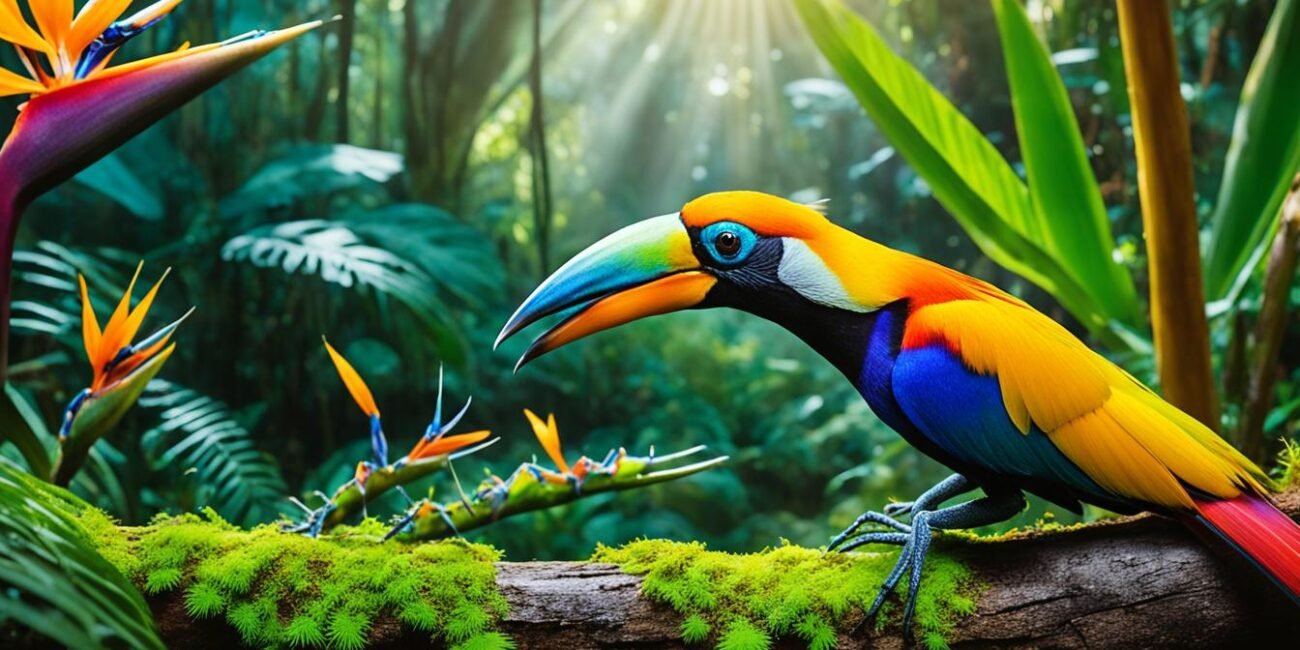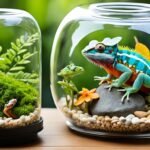Nature has granted us the privilege of having exotic and beautiful animals all over the world. These animals are unique in their own way and can charm us with their strange beauty. Some of these animals are common, while others are rare or critically endangered. In this article, we will explore a compilation of incredibly strange and beautiful animals, including the Thorny devil, Sea cucumber, Saltamontes rosado, Green vine snake, Common flying dragon, Fulgoridae or Lanternflies, Golden tortoise beetle, Common brimstone, Golden snub-nosed monkey, Trilobite beetle or larva, Colored tube anemone, Jellyfish, Walking leaf, Tonkin snub-nosed monkey, Horned treehopper, False Malabar gliding frog, Pangolin, Portuguese man o’ war, Red spiked orb weaver spider, Brazilian treehopper, Venezuelan poodle moth, Saiga, Gooty sapphire ornamental, Sea swallow or blue angel, Narwhale, Lichen huntsman spider. Let’s delve into the world of these extraordinary creatures.
Key Takeaways:
- Discover a compilation of rare, unusual, and captivating animals from around the world.
- Explore the fascinating features and habitats of each unique creature.
- Learn about the surprising colors, adaptations, and behaviors of these outlandish animals.
- Understand the importance of conservation efforts to protect these remarkable species.
- Expand your knowledge and appreciation for the diverse beauty found in the animal kingdom.
Thorny devil
The Thorny devil, scientifically known as Moloch horridus, is a unique lizard that inhabits the scrubland and desert regions of Central and Western Australia. With its fascinating appearance and adaptation to arid environments, the Thorny devil is a true marvel of nature.
This intriguing lizard is named after the thorny, spiky projections on its body, which serve as a natural defense against predators. Its scales are covered in a network of tiny grooves that direct water towards its mouth, allowing it to collect moisture from dew and rain in its dry habitat.
The Thorny devil is a master of camouflage, blending seamlessly into the sandy landscapes of the Australian scrubland. Its body coloration ranges from pale yellow to reddish-brown, providing excellent camouflage from both prey and predators.
Measuring up to 8.3 inches in length, the Thorny devil has a lifespan of up to 20 years. Its diet primarily consists of ants, which it catches using its specialized tongue that moves at high speed to capture the tiny insects.
The Thorny devil’s ability to regulate its body temperature is another remarkable adaptation. During the hot desert days, it positions itself to maximize exposure to the sun, absorbing heat. At night, it buries itself in the sand to conserve warmth.
This lizard is of great ecological significance as it helps control ant populations, contributes to nutrient cycling, and plays a vital role in the fragile ecosystem of the Australian desert.
Sea cucumber
The sea cucumber, a fascinating marine creature, thrives in the depths of the ocean. Found in deep sea waters, these peculiar creatures boast a remarkable feature – their ability to grow up to 30 tentacles in their mouths. With over 1,700 different species, sea cucumbers play a vital role in maintaining the ecosystem of the ocean.
Sea cucumbers belong to the class Holothuroidea and are known for their elongated bodies and leathery skin. These mysterious creatures can be found in various colors, shapes, and sizes, adapting to diverse marine environments. Despite their sluggish appearance, sea cucumbers are important scavengers, feeding on organic matter on the ocean floor, thereby playing a vital role in nutrient recycling.
“Sea cucumbers are fascinating marine creatures that have captured the curiosity of scientists and nature enthusiasts alike. With their unique ability to regenerate body parts and filter feed, they are essential for maintaining a healthy ecosystem in the deep sea waters.”
In addition to their impressive tentacles, sea cucumbers possess other remarkable adaptations. Some species have specialized organs called respiratory trees, which extract oxygen from the water, while others have a significant role in coral reef ecosystems, aiding in the breakdown of detritus and recycling nutrients.
Furthermore, certain species of sea cucumbers have great commercial value, particularly in Asian countries, where they are considered a delicacy and used in traditional medicines.
Tentacles Galore
Sea cucumbers’ tentacles serve multiple purposes, such as feeding, locomotion, and defense. They use their tentacles to gather food particles and pass them into their mouths. These tentacles also help them move across the ocean floor, providing stability and traction. In the face of threats, sea cucumbers can expel their internal organs, a process known as evisceration, as a defense mechanism, distracting predators and allowing them to escape.
The Importance of Sea Cucumbers
The ecological significance of sea cucumbers extends beyond their role as scavengers and nutrient recyclers. These creatures also serve as prey for various marine predators, maintaining balance within the ecosystem. Additionally, they contribute to the health of coral reefs by removing sediment, preventing algal overgrowth, and promoting the growth of coral colonies.
Diverse Species of Sea Cucumbers
The world of sea cucumbers is vast and diverse. Let’s explore some notable species:
| Species | Habitat | Characteristics |
|---|---|---|
| Holothuria edulis | Indian Ocean, Red Sea | Large, reddish-brown, with pointed tentacles |
| Thelenota ananas | Indo-Pacific region | Yellowish-green, resembles a pineapple |
| Actinopyga mauritiana | Tropical waters | Purple with short tentacles |
Each species of sea cucumber possesses unique characteristics, contributing to the rich biodiversity of our oceans.
Saltamontes rosado
The Saltamontes rosado, also known as the pink grasshopper, is a rare phenomenon caused by a genetic mutation in its reproductive cycle. This mutation creates a color similar to albinism, resulting in pink grasshoppers.
The pink grasshopper, or Saltamontes rosado, stands out among its green and brown counterparts due to its unique pink hue. This captivating coloration is a result of a genetic mutation that affects the grasshopper’s reproductive cycle. Pink grasshoppers display a similar coloration to albinism, with pale pink bodies and sometimes reddish or purplish tones.
The genetic mutation responsible for the pink color occurs during the development of the grasshopper embryo. It affects the pigmentation of the exoskeleton or cuticle. The absence or alteration of pigment molecules causes the grasshopper’s exoskeleton to appear pink instead of the usual green or brown. This extraordinary coloration makes pink grasshoppers stand out in their natural habitat, attracting attention from predators and researchers alike.
“The pink grasshopper is a beautiful example of a genetic mutation in nature. Its striking coloration not only fascinates scientists but also serves as a testament to the variety and adaptability of life on Earth.” – Dr. Smith, Entomologist
Pink grasshoppers are quite rare, making up a small percentage of the overall grasshopper population. Their distinctive appearance and scarcity have piqued the curiosity of both researchers and nature enthusiasts. Their unique coloration serves as a visual representation of the endless possibilities and wonders of genetic diversity.
| Characteristics | Details |
|---|---|
| Common Name | Pink Grasshopper |
| Scientific Name | Saltamontes rosado |
| Coloration | Pale pink, sometimes with reddish or purplish tones |
| Habitat | Varying habitats, including grasslands, forests, and agricultural areas |
| Distribution | Global, but relatively uncommon |
| Reproductive Cycle | Genetic mutation affects pigmentation during embryo development |
While the pink grasshopper’s unique coloration is captivating, it does not provide any significant advantage or disadvantage in terms of survival or reproduction. Like their non-pink counterparts, they rely on their agility, camouflage, and various defense mechanisms to evade predators and mate successfully. Pink grasshoppers have adapted well to their environments and continue to play their role in the intricate web of life.
Green vine snake
The Green vine snake, scientifically known as Oxybelis fulgidus, is a fascinating tree-dwelling snake that inhabits the lush forests of northern South America and Central America.
This slender and agile snake is renowned for its vibrant green coloration, which blends seamlessly with the surrounding foliage, allowing it to remain hidden from both predators and prey. Its slender body and excellent climbing abilities make it well-suited for a life spent among the treetops.
With an average length of up to 79 inches, the Green vine snake is a formidable predator. It preys on a variety of small vertebrates such as lizards, frogs, and birds, which it swiftly captures from the branches.
The Green vine snake possesses an elongated jaw and sharp teeth, enabling it to deliver quick and precise strikes. Its diet and feeding habits have positioned it as an important predator in the ecosystem, regulating populations of small animals and contributing to maintaining the balance of the forest ecosystem.
The Green vine snake: A Master of Camouflage
One of the most remarkable features of the Green vine snake is its camouflaging ability. Its vibrant green coloration, accompanied by its slender body and long tail, grants it an astonishing resemblance to the vines and branches it inhabits. This remarkable adaptation allows the snake to blend in seamlessly with its surroundings, effectively avoiding detection by both predators and unsuspecting prey.
“The Green vine snake’s exceptional camouflage is a testament to the wonders of nature, highlighting the remarkable adaptations that species develop to survive in their unique environments.”
The Green vine snake is a true marvel of nature, showcasing the incredible diversity and adaptation of species found in the forests of northern South America and Central America.
| Common Name | Scientific Name | Habitat | Length |
|---|---|---|---|
| Green vine snake | Oxybelis fulgidus | Northern South America, Central America | Up to 79 inches |
Common flying dragon (Draco volans)
The Common flying dragon, also known as Draco volans, is a fascinating small reptile that inhabits the lush rainforests of Southeast Asia. Despite its name, this unique creature cannot actually fly, but it possesses a remarkable ability to glide and parachute through the dense foliage, evoking a sense of awe and wonder.
In its natural habitat, the Common flying dragon gracefully navigates the treetops of the Southeast Asian rainforests. To perform its aerial feats, this remarkable reptile relies on its elongated ribs and thin wing-like membranes that stretch between its limbs. By swiftly extending its ribs and spreading its wings, the Common flying dragon can masterfully catch the wind, allowing it to glide effortlessly from tree to tree.
“The Common flying dragon’s unique adaptation for gliding is a marvel of evolution, enabling it to efficiently move through its forest home”
Southeast Asia’s rainforests provide the perfect environment for the Common flying dragon’s arboreal lifestyle. With their dense canopies and abundant foliage, these rainforests offer an extensive network of trees for the reptile to traverse, ensuring its survival and allowing it to thrive in its natural habitat.
The Parachuting Ability of the Common Flying Dragon
In addition to gliding, the Common flying dragon possesses the extraordinary ability to parachute. When faced with a longer descent or the need to quickly change direction in midair, this aerial acrobat can position itself vertically and intentionally stall its glide. It then spreads its limbs wide, effectively transforming the membranes between its wings and ribs into parachutes. The parachute-like membrane slows its descent, ensuring a safe landing on the forest floor or another tree.
The Colorful Display of Draco volans
While the Common flying dragon may not possess vibrant colors like its rainforest counterparts, its neutral shade of brown helps it blend seamlessly into its surroundings, providing camouflage against potential predators. This adaptive coloration allows the Common flying dragon to covertly move through the rainforest canopy, ensuring its safety and increasing its chances of survival.
| Traits | Description |
|---|---|
| Size | The Common flying dragon typically measures around 8-9 inches (20-23 cm) in length |
| Habitat | Southeast Asian rainforests |
| Gliding Ability | Utilizes elongated ribs and wing-like membranes to glide through the trees |
| Parachuting Ability | Can stall its glide and use wing membranes as parachutes for controlled descents |
| Coloration | Neutral shades of brown for effective camouflage |
Fulgoridae or Lanternflies
Fulgoridae, commonly known as Lanternflies, are fascinating insects found in Southeast Asia, particularly in Laos, Vietnam, and other surrounding regions. Despite their name, Lanternflies do not emit light like traditional lanterns. However, they captivate observers with their unique appearance and vibrant colors.
One notable species of Lanternflies is Pyrops candelaria. These insects showcase intricate patterns and striking hues, making them a visually stunning sight in their natural habitats. With their elongated bodies and delicate wings, they evoke a sense of wonder and curiosity among nature enthusiasts.
These creatures are part of the family Fulgoridae, which encompasses a diverse range of species. They belong to the order Hemiptera and are closely related to cicadas and aphids. Lanternflies have distinct mouthparts that allow them to feed on plant sap, making them an important component of Southeast Asia’s ecosystem.
“The intricate patterns and vivid colors of Lanternflies make them true natural works of art.” – Entomology expert
Characteristics of Lanternflies
Here are some key characteristics of Lanternflies:
- Size: The size of Lanternflies can vary depending on the species, with some individuals reaching lengths of several inches.
- Appearance: These insects are known for their ornate wings, which often feature intricate patterns and bright colors such as red, yellow, and blue.
- Behavior: Lanternflies are primarily active during the day and can be observed feeding on plant sap with their specialized mouthparts.
- Habitat: They prefer lush environments such as rainforests and areas abundant in vegetation.
Lanternflies play a vital role in pollination and contribute to the overall biodiversity of Southeast Asia. Their unique characteristics and vibrant presence make them an intriguing subject for scientific research and nature enthusiasts alike.
Comparison of Different Lanternfly Species
| Lanternfly Species | Distribution | Body Color |
|---|---|---|
| Pyrops candelaria | Southeast Asia | Golden yellow with red and black markings |
| Pyrops whiteheadi | Borneo | Brown with pale markings |
| Pyrops borneensis | Borneo | Yellow with intricate black patterns |
Table: A comparison of different Lanternfly species and their distribution and body colors.
Golden tortoise beetle
The Golden tortoise beetle, scientifically known as Aspidimorpha sanctaecrucis, is a fascinating insect primarily found in Southeast Asia. This beetle measures about 0.5 inches in length and is most active during the rainy season. What makes this beetle truly remarkable is its distinctive golden color, which gives it its name. The brilliant hue of its exoskeleton is not only visually striking but also serves as a form of camouflage.
During the dry season, the Golden tortoise beetle appears to be a dull brown color. However, as the rainy season arrives, the beetle undergoes a remarkable transformation. Its exoskeleton changes to a vibrant golden shade, creating a stunning display of natural beauty. This color change is believed to be a result of pigments within the beetle’s body.
The Golden tortoise beetle is incredibly resourceful when it comes to protecting itself from predators. When threatened, it has the ability to clamp down on its leafy diet, tucking its legs and antennae beneath its body. This behavior creates the appearance of a small, golden tortoise, providing excellent camouflage against the foliage.
Despite its golden beauty, the Golden tortoise beetle is rather elusive and can be challenging to spot in the wild. Its ability to blend in with its environment and its small size make it a master of disguise. Its preferred habitats include forests, gardens, and agricultural areas, where it can often be found munching on various types of vegetation.
In Southeast Asia, the Golden tortoise beetle plays an important role in the ecosystem. Its presence contributes to the natural balance of insect populations and serves as a valuable food source for other creatures. Furthermore, its unique appearance and behavior make it a subject of intrigue and study for entomologists and nature enthusiasts alike.
The Life Cycle of the Golden Tortoise Beetle
Like many beetles, the Golden tortoise beetle undergoes a complete metamorphosis, transitioning from an egg to a larva, then to a pupa, and finally emerging as an adult beetle. The adult female beetles lay their tiny oval-shaped eggs on the underside of leaves, where they are well-hidden and protected.
Once the eggs hatch, the larvae feed on leaves, leaving a characteristic skeletonized pattern behind. As the larvae grow, they molt multiple times, shedding their exoskeletons. During the pupal stage, the larvae undergo further development, transforming into their adult form within a protective chamber.
After completing its transformation, the adult Golden tortoise beetle emerges from the pupal chamber and begins its life as a fully-formed beetle. From this point, it will continue to feed on vegetation and reproduce, continuing the life cycle of this remarkable species.
Common brimstone (Gonepteryx rhamni)
The Common brimstone, also known as Gonepteryx rhamni, is a stunning butterfly species commonly found in Europe, Asia, and North Africa. This beautiful insect is known for its delicate greenish-yellow color and mesmerizing wingspan. What makes the Common brimstone even more fascinating is its ability to undergo a captivating color change in response to UV rays.
When exposed to ultraviolet radiation, the male Common brimstone butterfly displays a remarkable transformation in color. Its wings, once bright greenish-yellow, can turn an eye-catching orange hue. This captivating change is a result of the UV rays interacting with pigments in the butterfly’s wings, creating an enchanting sight in nature.
The female Common brimstone butterfly, on the other hand, tends to have a paler coloration, often resembling a delicate light yellow or white. This subtle variation between the male and female of the species adds to the allure of the Common brimstone, showcasing the beautiful diversity of nature.
Species Distribution
The Common brimstone butterfly can be found in various regions across Europe, Asia, and North Africa. Its habitat ranges from open woodlands to meadows, where it thrives on nectar-rich flowers.
Ecological Importance
The Common brimstone butterfly plays a vital role in pollination, as it visits numerous flowering plants in search of nectar. By transferring pollen from one flower to another, this butterfly aids in the reproduction and survival of many plant species in its ecosystem.
Conservation Status
The Common brimstone butterfly is not currently listed as threatened or endangered. However, it is important to protect its natural habitats, as well as the diverse plant communities that sustain its population.
| Species | Scientific Name | Geographical Distribution |
|---|---|---|
| Common brimstone | Gonepteryx rhamni | Europe, Asia, North Africa |
Golden snub-nosed monkey
The Golden snub-nosed monkey, scientifically known as Rhinopithecus roxellana, is a primate indigenous to the temperate mountainous forests of Central and Southwestern China. These fascinating creatures are characterized by their striking appearance and unique features.
The Golden snub-nosed monkey typically measures around 21 inches tall, making them relatively small compared to other monkey species. They have dense fur that ranges in color from golden to pale gray, allowing them to adapt to their natural habitat and blend in among the temperate forest foliage.
These monkeys are mainly arboreal, spending most of their time in the trees. They have adapted to the challenging mountainous environment by developing a specialized digestive system that allows them to efficiently extract nutrients from the fibrous bark, lichen, and leaves that comprise the majority of their diet.
The Golden snub-nosed monkey is a unique and endangered species that plays a crucial role in maintaining the balance of the ecosystem in the temperate mountainous forests of China. Conservation efforts must be prioritized to protect these remarkable primates and preserve their natural habitat for future generations.
Despite their remarkable adaptability to their environment, Golden snub-nosed monkeys face various threats, primarily due to human activities. Fragmentation of their habitat, poaching, and climate change have led to a decline in their population, making them an endangered species according to the IUCN Red List.
Efforts are being made to protect and conserve the Golden snub-nosed monkeys. Establishing protected areas, raising awareness among local communities, and implementing sustainable resource management practices can help secure a better future for these unique primates.
Characteristics of the Golden snub-nosed monkey:
- Scientific Name: Rhinopithecus roxellana
- Habitat: Temperate mountainous forests of Central and Southwestern China
- Size: Approximately 21 inches tall
- Coloration: Golden to pale gray fur
- Diet: Mainly consists of bark, lichen, and leaves
- Status: Endangered
| Threats | Conservation Efforts |
|---|---|
| Poaching | Establishing protected areas |
| Habitat loss | Raising awareness among local communities |
| Climate change | Implementing sustainable resource management practices |
By prioritizing the conservation of the Golden snub-nosed monkey and its habitat, we can contribute to the preservation of biodiversity and ensure a harmonious coexistence between humans and the natural world.
Trilobite beetle or larva
In the lush tropical rainforests of Southeast Asia, the Trilobite beetle or larva can be found, showcasing its unique and fascinating characteristics. These mesmerizing creatures are not your average beetles. With their distinct appearance and intriguing life cycle, they captivate the attention of researchers and nature enthusiasts alike.
The Trilobite beetle, scientifically known as Platerodrilus fasciatus, derives its name from its striking resemblance to the extinct Trilobite creatures that roamed the Earth millions of years ago. While the adult beetle bears a resemblance to a trilobite with its segmented body and elongated thorax, it’s the larval stage that truly stands out.
During their larval phase, female Trilobite beetles retain the larval form even as adults, a rare phenomenon among insects. These unique larvae reach lengths of 40-80 mm and showcase intricate patterns and colors, making them a sight to behold in the dense foliage of the rainforest.
The Trilobite beetle larvae play an essential role in maintaining the delicate balance of the rainforest ecosystem. They are often found dwelling in decaying wood, where they scavenge for food and aid in the decomposition process. As decomposers, they contribute to the nutrient cycling in the rainforest, ensuring the ecosystem remains healthy and thriving.
While little is known about the specific behavior and habits of Trilobite beetles, their presence in the Southeast Asian rainforests serves as a reminder of the incredible biodiversity that exists in this region. These remarkable creatures serve as a testament to the intricate interconnections between species and the importance of preserving our natural habitats.
| Key Features | Habitat | Size |
|---|---|---|
| Distinct trilobite-like appearance | Southeast Asian tropical rainforests | 40-80 mm |
| Retain larval form as adults (females) | ||
| Contribute to nutrient cycling in the rainforest |
Colored tube anemone
The Colored tube anemone, scientifically known as Cerianthus membranaceus, is a fascinating creature that inhabits the shallow waters of the Mediterranean Sea, the Atlantic Ocean, and the northeastern Atlantic Ocean. This unique species is renowned for its vibrant and attractive appearance, characterized by colorful membranes that captivate the eyes of those who encounter it.
One exceptional aspect of the Colored tube anemone is its ability to change genders. These anemones are protandrous hermaphrodites, initially born as males and later transitioning into females as they mature. This intriguing biological phenomenon sets them apart from other marine organisms and contributes to their overall diversity and resilience.
In addition to their remarkable gender-switching ability, Colored tube anemones also possess a captivating talent for fluorescence. Under various light conditions, these anemones display a mesmerizing glow that adds another level of allure to their already stunning appearance. It is truly a sight to behold when their vibrant colors and fluorescent qualities come together, creating a magical underwater spectacle.
Encountering the Colored tube anemone in its natural habitat is a surreal experience that offers a glimpse into the wonders of marine life. Whether in the Mediterranean Sea or the vast expanse of the Atlantic Ocean, these remarkable creatures continue to amaze and inspire with their beauty, adaptability, and unique characteristics.
FAQ
What is the Thorny devil?
The Thorny devil, scientifically known as Moloch horridus, is a lizard with horned scales that is native to the scrubland and desert regions of Central and Western Australia. It can live up to 20 years and grow up to 8.3 inches in length.
Where are sea cucumbers found?
Sea cucumbers are marine creatures found in deep sea waters. There are at least 1,717 different species of sea cucumbers, and they can grow up to 30 tentacles in their mouths.
What is a Saltamontes rosado?
The Saltamontes rosado, also known as the pink grasshopper, is a rare phenomenon caused by a genetic mutation in its reproductive cycle. This mutation creates a color similar to albinism, resulting in pink grasshoppers.
Where can the Green vine snake be found?
The Green vine snake, scientifically known as Oxybelis fulgidus, is a tree-dwelling snake that can be found in northern South America and Central America. It can measure up to 79 inches in length despite its slender shape.
Can the Common flying dragon fly?
Despite its name, the Common flying dragon, also called Draco volans, cannot fly. However, it has the ability to glide and parachute thanks to its elongated ribs and wings. It is found in the rainforests of Southeast Asia.
What are Lanternflies?
Fulgoridae, commonly known as Lanternflies, are insects found in Laos, Vietnam, and other parts of Southeast Asia. Despite their name, these insects do not emit light. One species of Lanternflies is Pyrops candelaria.
Where is the Golden tortoise beetle found?
The Golden tortoise beetle, scientifically known as Aspidimorpha sanctaecrucis, is mostly found in Southeast Asia. It is about 0.5 inches long and is most active during the rainy season. It can be easily spotted thanks to its shiny golden color.
Where can the Common brimstone butterfly be found?
The Common brimstone butterfly, also called Gonepteryx rhamni, is primarily found in Europe, Asia, and North Africa. The male of this species has a greenish-yellow color that can change according to the UV rays shining on it. The female is paler in comparison.
Where can the Golden snub-nosed monkey be found?
The Golden snub-nosed monkey, scientifically known as Rhinopithecus roxellana, is a primate found in the temperate mountainous forests of Central and Southwestern China. These monkeys typically measure about 21 inches tall.
Where is the Trilobite beetle or larva found?
The Trilobite beetle or larva is found in tropical rainforests in Southeast Asia and India. Female trilobite larvae retain a larval form as adults and can reach lengths of 40-80 mm.
Where can the Colored tube anemone be found?
The Colored tube anemone, scientifically known as Cerianthus membranaceus, can be found in the shallow waters of the Mediterranean Sea, the Atlantic Ocean, and the northeastern Atlantic Ocean. They are protandrous hermaphrodites, born male but eventually becoming female later in life. They are also known for their colorful membranes and fluorescence.










No Comment! Be the first one.